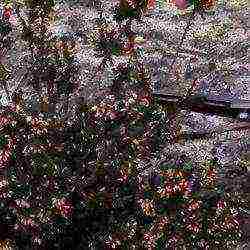Content [show]
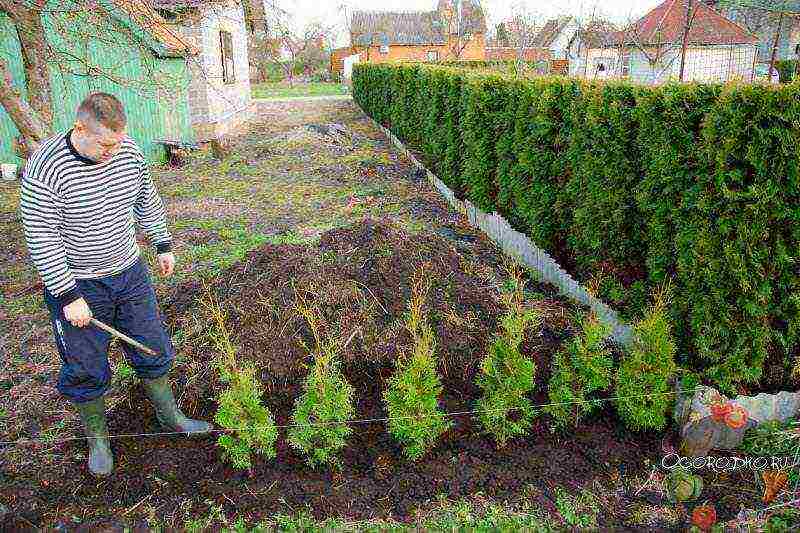
A beautiful thuja, planting and caring for which in the open field turns into a real torment for many, in reality is not a difficult process if the correct agricultural technology is followed. You need to know at what time it is better to plant, at what distance from each other, where the root collar should be located, whether it is necessary to fertilize when planting, etc.
How to choose the right thuja seedling for planting?
In landscape design, many summer residents and owners of private houses use coniferous beauty, and there are 3 traditional ways of its reproduction - seeds, cuttings and seedlings. The latter is especially popular, since thuja, planting and care in the open field, for which does not require significant effort and labor. But, for a start, you should competently approach the choice of the thuja sapling itself.
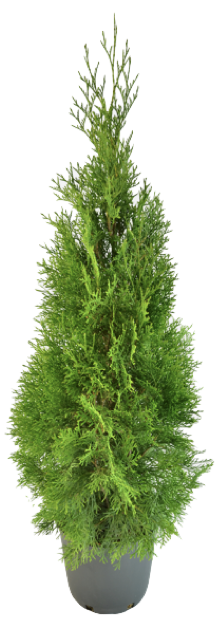
There are several points that you need to pay attention to when buying thuja seedlings:
- sprouted thuja seedlings can be purchased with an open root system (OCS), dug out of the ground, or closed (in a pot) and it is better to buy them in specialized nurseries or stores, where experienced employees will help you choose the right variety and buy a healthy strong thuja tree, which will be adapted under the local climate
- you need to inspect the thuja branches - they should not be dry and bend well
- you should touch the needles of the plant - on a healthy thuja seedling, it will hold firmly and will not crumble
- you need to carefully examine the tree - the presence of spots on the trunk or twigs of the thuja indicates a violation of the cultivation technology or a disease
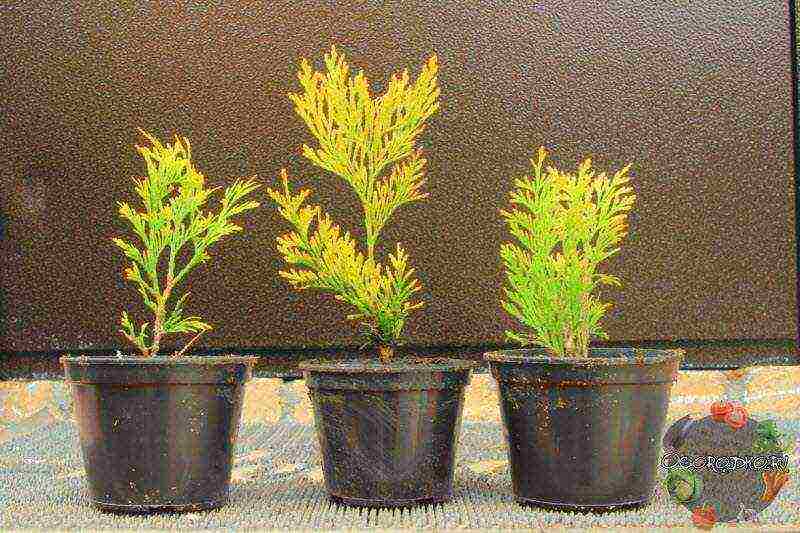
You can also purchase a small thuja seedling, which should first be grown, and only then planted in the place of growth. In addition, when buying, pay attention to the variety that should be suitable for the climatic growing conditions. For example, thuja western, whose varieties are diverse, looks great in landscape design and can be planted in different parts of our country.
Thuja - planting in open ground
Before moving on to the question of how to plant a thuja seedling, you need to decide on the place of growth - it should be lighted, with light shading, without drafts. It is necessary to provide a good nutrient medium in the form of a soil mixture - you need to mix turf soil with peat and sand in the same proportion.
You should also think about what time of year to plant thuja, but here everything is quite simple - if the seedling is purchased in a pot, any time will do, except late autumn and winter. The optimal time for planting thuja is the spring months (April or May). If you bought a thuja seedling with an open root system, it should be planted immediately or buried in a cool, shaded place, well covered with soil or sawdust (wet). Usually planted in the spring after thawing the soil and before the foliage of fruit trees. Or in the fall, after the beginning of leaf fall and before the first frost.
But, it is worth remembering that in the Urals and Siberia, the Leningrad region and other northern regions, planting is carried out only in spring and summer in order to avoid the death of the plant in the fall due to sudden frosts.In the Krasnodar Territory, including the Kuban, Stavropol Territory, the Rostov Region, thuja can be planted both in spring and summer, and in autumn due to climatic features; in the Moscow Region, experienced gardeners recommend completing work by the end of August.
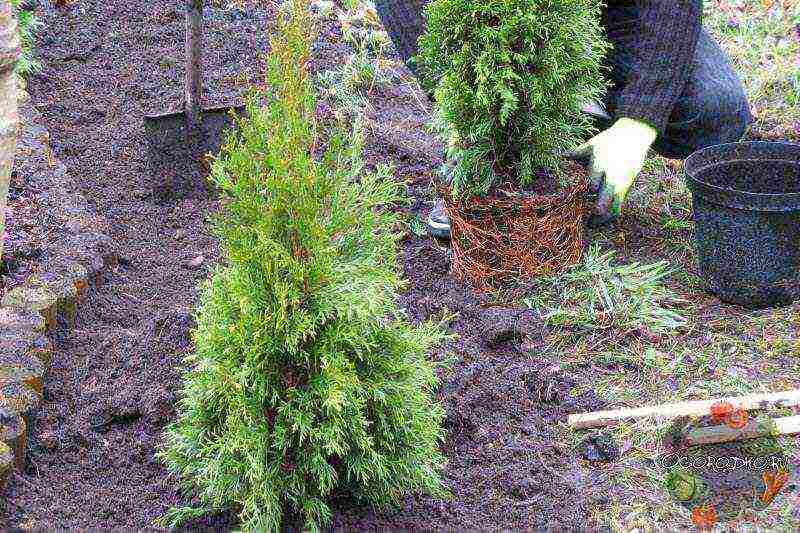
Direct landing should be done in stages:
1. Dig a hole... The main criterion for the size of the hole is an earthen lump around the roots of a thuja seedling with a closed system, or the roots of a thuja tree with ACS, the depth of the hole should be 20 or 25 cm more, in width - by 30 or 40 cm
2. Add compost... Rotten manure or earth mixed with wood ash is suitable for him - you should fill the bottom of the hole with it by about a third
3. Remove air bubbles from the roots - for this, the root system of the thuja seedling must be kept in water until the bubbles appear. In addition, in thuja with ACS, damaged roots should be removed, and cut too long
4. Plant a thuja tree - set the seedling in the center of the hole, while the root collar of the thuja when planting should be 2 cm above the level of the soil surface, so as not to fall asleep. In thuja with open roots, you need to carefully straighten the roots, directing them down, and then sprinkle the hole with the roots with the prepared soil mixture and slightly compact so that the thuja has a strictly vertical position
5. Provide abundant irrigation... For one thuja seedling, you will need at least 1.5 standard watering cans. The bioregulator of growth Epin (1 ampoule for 5 liters of water), which can be added to water, will help to adapt and stimulate the roots of thuja.
6. Load mulch... The soil usually subsides after watering. It is worth placing mulch in this groove in the form of chips or sawdust. But not close to the trunk of the thuja, as they can snatch under the sun
If necessary, plants with ACS can be tied to a peg for support. The distance between thuja during planting depends on the purpose of planting - growing hedges requires a distance of 1.5-2 m.When framing alleys and paths, the interval should be increased to 3-4 m.In the first time after planting, it is better to provide the thuja seedling with a shadow (for a couple weeks) But in order to know how to care for thuja in the garden, you must follow a number of activities that will ensure healthy, beautiful plant color and growth.
Thuja - outdoor care all year round
Despite the fact that thuja is an unpretentious plant, even she needs careful care, which includes several components:
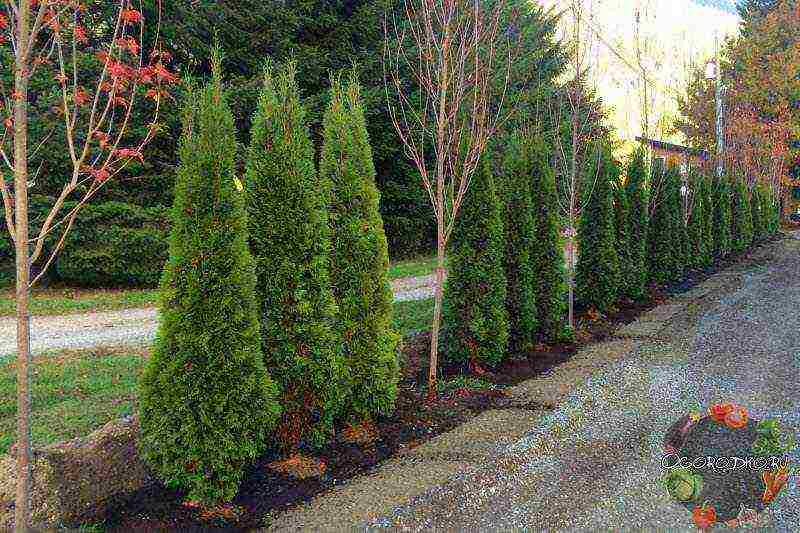
1. Watering... With a lack of moisture, the thuja trees will turn yellow, the crown will become rare. Therefore, it is necessary to ensure watering with regularity at least 2 times a week (with a small amount of rain). For one young thuja seedling, at least 10 liters of water will be required. As you grow, the number should be increased. For adult thuja trees, you need about 50 liters of water. Additionally, you need to do irrigation once a week. In hot weather, these activities should be carried out daily (morning or evening)
... Thuja, planting and care in the open field for which is not too difficult, requires loosening of the near-trunk zone with the removal of weeds, which is an obligatory component in the complex of cultivation measures. In the process of loosening, it is not necessary to go more than 8 cm into the ground, so as not to damage the roots of the thuja. Weeds should be removed at the same time. After finishing, you need to carry out the mulching procedure (with sawdust or peat chips)
3. Top dressing of thuja is carried out when watering 2 years after planting in the spring, and here you can use the fertilizer Kemira-universal (for 1 m² 100 g). In addition, it is worth knowing how to cover the thuja for the winter and how to feed it so that the plants overwinter comfortably.
4. Pruning - necessarily included in the care of thuja after planting in the spring, has a good effect on the development of the plant and growth, stimulating the plant to the appearance of new branches. Thuja haircut should be done in the 3rd year of life, before the buds open. Another haircut is required at the end of August.After the thuja grows to the desired height, you can begin to form the crown
5. Treatment of diseases... If signs of fungus are found, the thuja should be treated with special solutions Kartotsid, Bordeaux liquid
There is nothing difficult in how to care for a thuja after planting, the most important thing is not to miss a single component, and then the tree will quickly grow and delight with a lush crown and rich green color.
Thuja has been used for a long time in the design of paths, the formation of hedges and landscape design, it is appreciated for its good adaptation to climate conditions, unpretentiousness and original appearance. Thuja, planting and care in the open field is simple, does not require much effort and will allow you to grow an amazing green beauty in your area in a short time, which will exude a wonderful aroma and enrich the air with useful phytoncides.
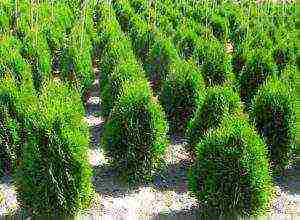
A wonderful and interesting plant thuja, planting and care in the open field of which will not cause much trouble, can be seen in many summer cottages. Conifers are especially loved by owners of personal plots and private houses, and the thuja tree is an unpretentious, frost-resistant and very beautiful plant. From it you can form figures for landscape design, decorate paths, decorate beautiful corners of the garden.
Varieties of thuja
There are many types of tui, and it will not be possible to list everything in a brief overview, so you can dwell on the most popular ones:
- The most common type of thuja is the Western thuja Smaragd. This is a tree that looks like a cypress, it can grow up to 5 m. The needles of the Western thuja are emerald in color all year round. The thuja grows in any soil, but it is more comfortable in calcareous or loamy soil. The plant is frost-resistant, areas open to sunlight or partial shade are suitable for it. It does not grow quickly and is ideal for the formation of hedges and garden figures.
- Another representative of Western thuja is Golden Smaragd. The shade of the branches casts gold, hence the name. This tree grows up to 2 m, the shoots are short and form a crown in the form of a cone. As for the land, Golden prefers fertile soil, does not like dirty city air, so it is better to plant it in the country. Poorly tolerates direct sunlight
- Western Danica is a globular shrub about 1 m in height. It grows slowly, so this species is often used as a curb or hedge.
- The Aureya variety has a yellowish color of needles - it is a dwarf shrub that does not require cutting.
- Brabant is a giant that can grow up to 20 m, and the tree grows quickly - in a year it adds up to 40 cm in height and up to 15 cm in width. The color of the needles does not change during the year and remains deep green.
Among the Eastern thujas, there are more than 50 varieties. They are more demanding, and it is a little more difficult to care for them, but with proper care of trees and shrubs, you can get a real decoration of the site. Eastern thujas are heat-resistant and tolerate drought well; stony soil is suitable for them.
Planting a tree
Thuja loves light, but if you plant it in direct sunlight, it will lose a lot of moisture, and it will be difficult for it to survive the winter. The place for the thuja must be selected light, but at noon there should be partial shade or shade, especially this rule applies to variegated and yellow thuja, otherwise their color will be pale.
It is better to plant a tree on a cloudy spring day; it is undesirable to do this in autumn, since there is no guarantee that she will have time to adapt to the new environment before winter.
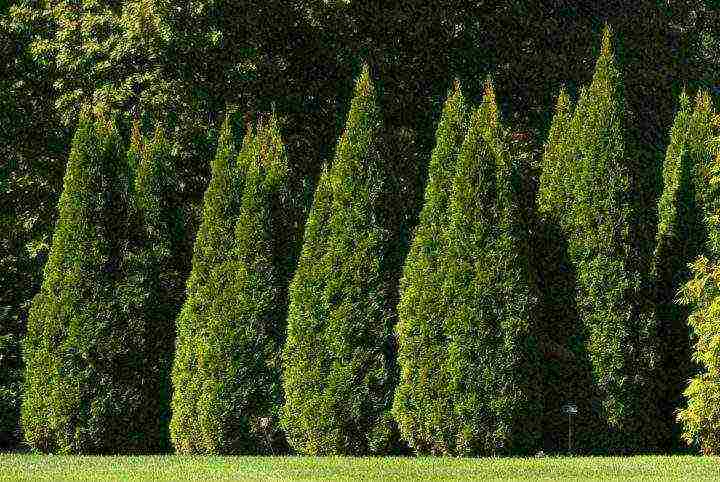
Tui on the site
It is necessary to plant thuja at a distance of at least 3.5 m from each other. The size of the planting pit depends on the size of the seedling roots. The depth should be approximately 25-30 cm more than the root with a lump of earth, and the width should be 35-40 cm wider. The root collar should be level with the ground.
At the bottom of the pit, drainage and a layer of compost are laid out.Then the root of the plant is covered with a mixture of sand, turf and peat. After the pit is filled, it is necessary to compact the soil well and water the plant abundantly so that the soil is completely saturated, mulch with mowed grass, crushed tree bark and peat. This layer will protect the thrown from both heat and low temperatures. But it is worth making sure that the mulch does not cover the trunk and lower branches, otherwise they can rot.
Care after landing
How to care for thuja after planting? This plant, although drought-resistant, is also moisture-loving. In the first week after planting, it must be watered in the morning and in the evening, after the seedling takes root and grows, the plant must be watered in the summer every 5 days with 10 liters of water, and in the fall and spring it must be guided by the weather. An adult tree is watered once every 2 weeks with 30 liters of water, after 5 years it can already be watered only in hot and dry days.
Thuja care involves periodic sprinkling, while the age of the plant does not matter. So the tree receives an additional source of moisture, its foliage is freed from dust and dirt, and the air is filled with a coniferous aroma. Sprinkling can be done in the morning and in the evening, with the exception of cold nights and hot sunny days, when the moist foliage of the plant can be damaged.
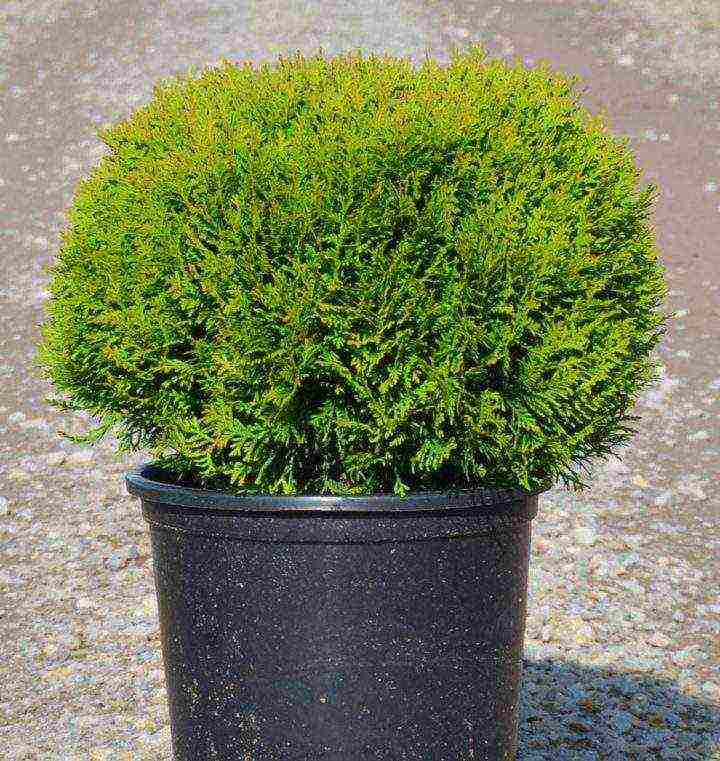
Thuja in a pot
Do not think that when pruning, damage to the plant is caused. Correct pruning is one important and necessary maintenance point. All types of thuja need pruning. If there are doubts about pruning, then it is better to contact a professional and see how he will form this shrub.
Top dressing of thuja
The care and cultivation of thuja is also the fertilization of the plant. What top dressing to use depends on the soil in which the thuja grows. You need to feed the plant if:
- it is necessary to improve the agricultural background;
- quickly provide the plant with nutrients;
- if the plant was transplanted in the fall.
Caring for thuja in the fall also involves feeding the plant. To do this, use compost, bone meal, wood ash, peat. This will help the plant to winter safely. In the spring, it is advisable to feed the thuja with organic fertilizers, the plant reacts well to mineral fertilizers - potash and nitrogen.
How to prepare thuja for winter
In summer cottages in the first year of planting for the winter, it is better to cover the thuja. You can make a bag of non-woven material (spunbond, lutrasil) and put it on the plant, making sure that the needles are not overtightened.
If the winters are snowy and windy, then you can make a wooden frame, install it around the thuja, and stretch the fabric over the frame. This will help shield the branches and prevent snow from accumulating on the top of the plant. The root system must also be insulated by preparing mulch and covering the ground around the trunk of the plant with it.
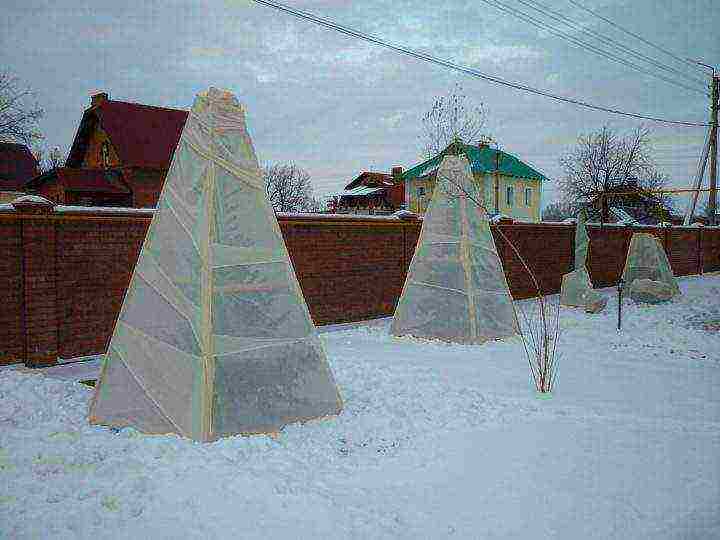
Shelter thuja for the winter
If the plant is already mature and well-rooted, then winter care will consist in removing excess snow from the branches so that the thuja foliage does not melt, and the branches do not break under the weight of the snow cover. Before the start of frost, it is necessary to water well the thuja so that the earth is moist.
When spring comes, do not rush and remove insulation and shelter - the plant must adapt. The bag must be removed on a cloudy day. When the wind dies down, you can remove the wooden frame. If the spring is sunny, it is advisable to make an awning over the thuja so that at first it is in the shade.
Thuja pests
One of the pests of the plant is the thuja aphid - tiny insects that live in large colonies and look like white dust. If the thuja was attacked, then its needles will turn yellow and fall off.
To get rid of pests, cover the ground under the plant with cellophane and rinse the affected areas with soapy water. This should be done within 1-2 weeks.
A spider mite is especially dangerous for thuja, it cannot be confused with another pest, because it envelops the plant with cobwebs. As a result, the needles become covered with yellow spots and fall off.
You can cope with a spider mite by spraying the plant with infusion of garlic or dandelion. If the lesion is too large, then acaricides are used. The tick does not like moisture, so it is worth spraying it with cold water.
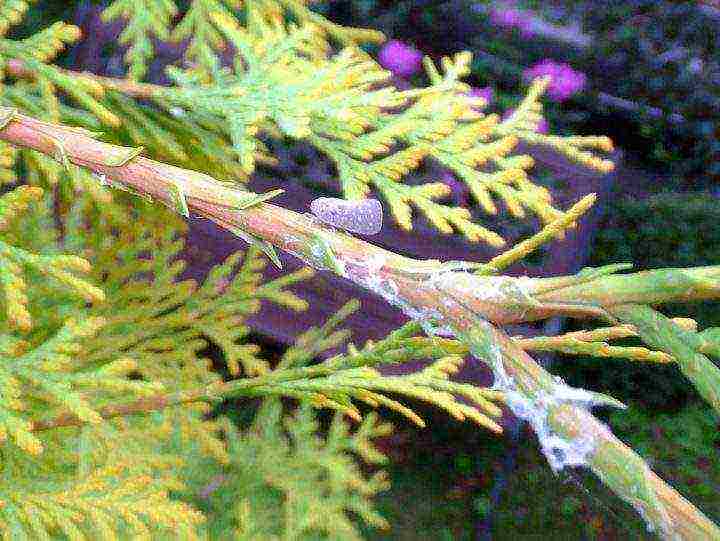
Tuya is waiting for treatment
The speckled moth gnaws thuja branches. If traces of this pest are seen, then it is better to cut off the affected branches. A completely affected plant must be treated with pyrethroid agents.
The leafworm makes spider cocoons by weaving thuja needles into them. The drugs Profi, Fufanon or Decis will help get rid of it.
Root click beetles feed on the roots of the tree. To remove them, you can use Zemlin, Trap or Bazudin.
Thuja diseases
Fungal infection (brown shoots) manifests itself in early spring. The bark scales turn yellow and the shoots begin to die off. It is recommended to use the antifungal agent Fundazol, and remove the affected branches. In order to prevent the infection of thuja with a fungal infection, it is necessary to sprinkle the roots with limestone.
Young thujas often suffer from rust. The causes of this disease may be lack of nutrition, dry air, high humidity. To prevent this disease from hitting the plant, in the spring, conifers should be sprayed with HOM.
If the needles darken and fall off, then, perhaps, she was struck by the fungal disease shyute. It is also most often found in young plants. To get rid of it, it is recommended to spray the plant with Topsin-M; Bordeaux liquid can be used as a prophylaxis. With proper care and timely prevention, thuja is not as susceptible to disease as other conifers.
Among the variety of conifers, thuja is especially loved by summer residents, owners of private houses. This is not surprising - thuja is frost-resistant, unpretentious, aesthetically attractive. Planting and care in the open field will not require significant work from the summer resident, but its presence on the site will be positive from any point of view. It is great for the formation of hedges, with its help you can create unique green shapes for landscape design of the site, arrange paths.
This tree, like its coniferous counterparts, exudes a wonderful aroma, enriches the air with useful phytoncides. Thuja carries a lot of positive qualities.
Thuja differs from pine or spruce in that it has no needles, its branches are covered with small green scales, soft, pleasant to the touch. It is tacitly called the "royal tree" - it is well deserved. We will consider the nuances of planting, caring for the coniferous beauty thuja, so that it takes root on your site too.
↑ to contents ↑ Thuja tree - selection of seedlings
If you do not plan to reproduce thuja independently, then you can purchase ready-made, grown seedlings. They can be purchased from ephedra nurseries or specialist shops. There, among the declared assortment, you will choose the desired variety, buy a healthy tree, adapted to the local climate.
Small thuja from nurseries vary in size and age. If you have a small seedling, then it will not be difficult to "grow" it yourself until it is planted in a permanent place of growth. You can also purchase a large copy, ready for the decoration of the site or the local area.
When choosing, always pay attention to the conditions of the plants, the degree of soil moisture in the containers, the strength of the coniferous scales on the branch. The branches of the seedlings should be elastic, the needles should not crumble, they should not have any spots or signs of disease. Upon arrival home, hurry up to transplant them to a shaded place, water.
↑ back to contents ↑ Planting thuja in the ground
Thuja will perfectly take root on your site at any time of the year, except in late autumn or winter. Experienced gardeners advise exactly the spring period - April, May.Planted in spring, it will hurt less, grow faster, and adapt better to the environment.
The landing site should be slightly shaded, consider this factor when planning the landscape design of the site. In direct sunlight, the tree will wither, and subsequently it will be worse to endure the winter cold. In a completely dark place, thuja will slowly develop, the branches will not be lush, bright. The ideal territory for it will be a windless section of the site, with light shading, close occurrence of groundwater.
Thuja - planting and leaving, phased actions:
- First, we dig a rather deep hole - 80-100 cm deep, with the same diameter dimensions (if you, of course, have a large seedling, and not the one in the photo above). The deepening should be such that a tree with an earthen lump can freely enter there. At the bottom we pour a little earth mixed with wood ash or other organic fertilizer.
- We put it in a hole, while its root collar should be at the same level with the soil surface.
- Mix the dug earth with sand, peat (1: 1), fill a depression with a seedling with this mixture, and then slightly trample.
The distance between the trees should be determined according to the characteristics of the variety, since thuja are very small and, conversely, very tall. Small trees can be planted a meter apart, large trees about 4-5 meters. Some varieties of thuja reach 15-20 meters in height, and their crown grows in breadth up to 3-4 meters (for example, thuja western Brabant). For full development, such a tree needs space, but when decorating alleys, green corridors, hedges, thuja are planted at a distance of 1 meter, regardless of the variety and type.
Tui Western Smaragd and globular Danica↑ back to contents ↑ How to care for thuja
Competent care of this ephedra implies watering, feeding, loosening the trunk circle, and forming a crown. After the tree is planted at its permanent place of residence, primary feeding is done. For these purposes, natural growth stimulants are often used (most gardeners choose "Epin"). The ingredients of such dressings contribute to better rooting of the tree, improve resistance to diseases. In the spring, you can feed it with potassium-phosphorus supplements, it is better to do this twice, the break between fertilizers should be 10-15 days.
In spring, the frequency of irrigation is influenced by the amount of rain, with the onset of summer it is enough 2 times a week, in the spring - 1 time. If the rains are frequent, then there is no need to water, there will be enough rain moisture. Thuja requires high-quality watering at all stages of life (seedling, adult tree), while the crown also loves irrigation. In order for the branches to be elastic, shiny, to please you with the brightness of green shades, the minimum amount of water for the root area should be 10 liters per watering (once a week, if the summer is very dry, then up to 3 times). Determine the lack of moisture by the state of the top of the thuja - it begins to turn yellow. It is better to water the trees early in the morning or in the evening.
Tuya is very fond of irrigating the crown, for these procedures, the acquisition of a special nozzle becomes relevant. From such sprinkling, dust is washed off, a fresher appearance of the tree is provided, a pleasant coniferous aroma begins to stand out. Do not be afraid to overdo it with irrigation, 1-2 times a day will only benefit thuja.
Returning to fertilizers, it is worth noting that too frequent fertilizing for thuja is not required. Special mineral compositions for conifers (for example, "Fertika") or compost, which has already become a classic additive, is enough to use twice a season - in spring and summer. Fertilizers are applied during loosening: they are laid out in the near-trunk circle, and during plowing they are mixed with the top layer of the soil. In summer, the additive can be diluted with water and used for irrigation.
The near-trunk area must be periodically cleaned of weeds, loosened, mulched with sawdust or compost. Decoratively painted sawdust (they are painted with natural ingredients) or nutshells look very attractive. Mulching creates some barrier to weeds, retains moisture, and improves the condition of the tree as a whole.
As for a haircut or artistic pruning, it is better not to touch it for the first two years of a tree's life, it should take root in its place. You can start caring for the crown from the third year from the moment of planting. Initially, dried, weak branches are removed, and the degree of density is determined. Excessive thinning negatively affects the decorative qualities of the tree, everything should be in moderation.
The main pruning is carried out in April, and then only the shape is corrected. For high-quality air circulation, maintaining the "vigorous" appearance of thuja, gardeners recommend removing all branches of annual growth.
If the artistic intention requires the tree to grow in breadth, then only the upper part of the crown should be trimmed. From tui, you can create various geometric shapes, columns, figures of animals or fairy-tale characters. For beginner gardeners, it is quite easy to give the crown of a tree the shape of a ball, cascade, border. Trimming or pruning is best done in dry weather.
↑ to contents ↑ Tuya - preparation for winter
For colder regions of the country, frost-resistant varieties of tui (western) should be chosen. Despite their unpretentiousness, they also require preparation for the cold season. In the fall, it is necessary to provide the trees with abundant watering, since even in winter the thuja continues to develop, albeit at a slower pace.
In the first years of life, young representatives must be insulated. With the help of a dense plastic film, non-woven spunbond or other suitable covering material, a kind of cocoon is formed, which will retain heat and let the sun's rays through. You can even buy special covers designed for this very purpose, they are sold by the garden departments of supermarkets or online stores.
For the winter, the roots are covered with fallen leaves, which are harvested with the onset of spring, as soon as the upper layer of the earth thaws. The overgrown crowns of adult thujas are neatly tied with a wide ribbon to prevent the accumulation of snow on the branches.
To please the eye, there was a healthy thuja, planting and care in the open field should be done competently, in a timely manner. This tree is quite unpretentious, but the result of simple care is expressed not only by its external beauty, decoration of the territory. A green hedge made of thuja will absorb noise from the street, neighboring territories, and also protect your site from prying eyes.
Due to its decorative qualities, the dwarf spherical thuja is a welcome guest on the site. This plant looks great both in a regular garden and as a stand-alone decoration. To grow a beautiful coniferous ball on your site, you should not only plant it correctly, but also properly care for the plant.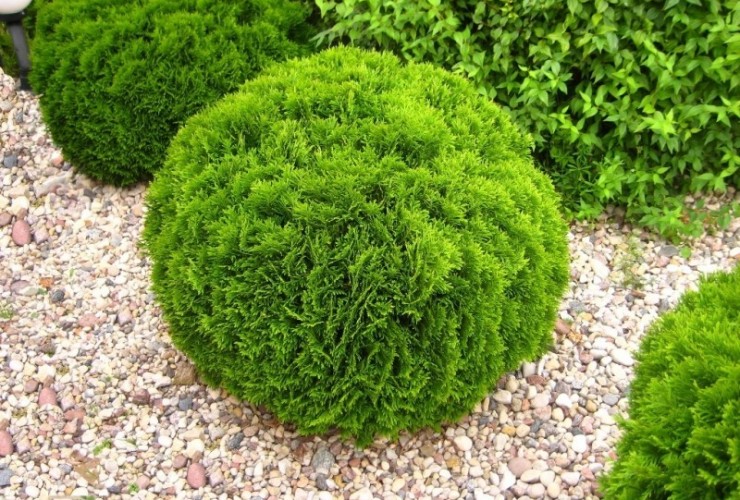
Varieties and types of thuja globular
Brabant. This variety is used for hedges. After all, the height of this thuja reaches 5 meters, and the diameter is 1.5 meters. In one year, Brabant grows 30 centimeters in height and 15 in width. You can buy it in the nursery at any time of the year and of any size.
Fresh articles about garden and vegetable garden
Columna. The silhouette is similar to the Crimean cypress trees. It grows up to 7 meters in height and up to 1.3 in diameter. These plants are great for recreating the Mediterranean style.
Emerald. Also resistant to frost and large gusts of wind. It grows up to 5 meters in height. However, this thuja is demanding on growing conditions and its growth rate is slow.
Holmstrup. It is the perfect thuja for lazy gardeners as it does not require much maintenance. Holmstrup is able to form a dense wall.Taking into account the slow growth rate, in 10 years it can grow by 3 meters in height.
Fastigiata. In central Russia, the height of this thuja reaches 6 meters. It makes a good hedge for covering unsightly landscapes or fencing off neighbors.
Wagneri. The maximum height of this tree is 4 meters. It tolerates frost very well, but does not like snowfalls. For planting this variety, it is better to choose an open place.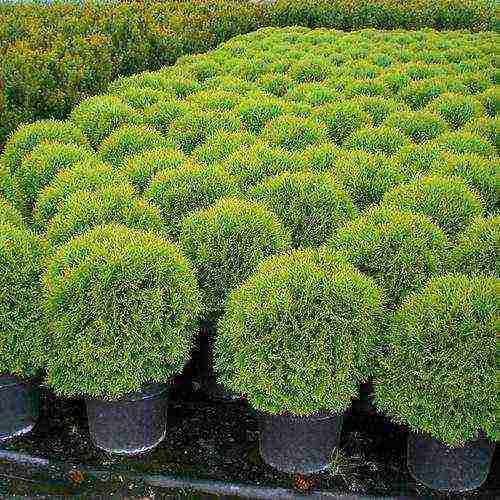
Features of planting thuja spherical
The first issue that must be resolved by the owner is choosing a suitable place for this thuja. And in order not to be mistaken, it is necessary to take into account the peculiarities of the variety you have chosen.
Thuja, including Teddy varieties, will feel best in a place that will be reliably protected from sunlight throughout the day.
When the issue with the planting site is resolved, it is necessary to imagine to what size this plant can grow in 5-10 years. If you decide not to limit yourself to one tree and plan to plant several plants, then they must be placed at least 50 cm from each other.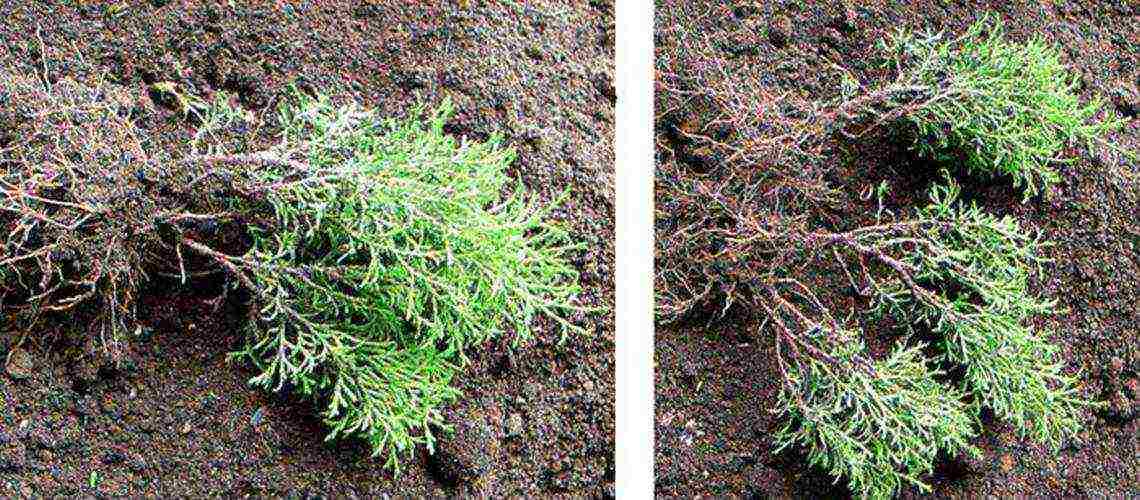
Choosing a place and planting a thuja
You are now familiar with the main varieties of spherical thuja. How do you grow these cute shrubs? You should start by choosing a place.
Fresh articles about garden and vegetable garden
Experienced gardeners say - thuja can grow on any site. But to improve the appearance, it is better to choose a bright place. In the shade, coniferous shrubs can lose their splendor and change color. It is important that there are no drafts in the selected area.
Two weeks before planting, you need to prepare a hole. The depth should not exceed 70-80 cm. Drainage must be laid on the bottom. The soil must be prepared independently: it is necessary to mix two parts of sod land and one part of peat and sand. It is worth adding 5 grams of nitroammophoska to the mixture. It is best to plant thuja in open ground in a permanent place at the age of 5-7 years. It is worth doing this in the fall, before frost, or in early spring.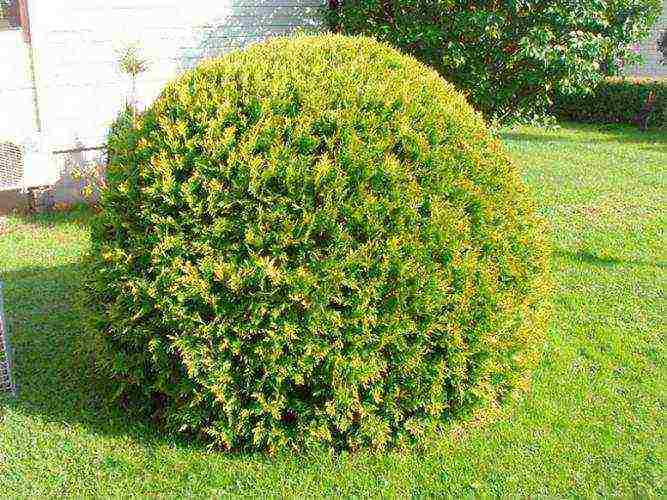
It is important to keep the spacing between plants. For small spherical thujas, it should not be less than one meter. After planting, the plant will need watering and feeding. Any growth stimulant is perfect. The substances that make up them will help the plants to take root and protect the seedlings from diseases.
Thuja spherical planting
The size of the hole depends on the variety, but usually the depth does not exceed 80 cm and the diameter is about a meter. Focus on the root system and the size of the pot, the neck of the bush should be level with the ground. It is very important to choose the right place. Keep in mind that most of these evergreen flora do not like to grow in the open sun. If you want to land several on the site, then you need to maintain a distance of at least half a meter between them. Now let's proceed directly to the resettlement of a new resident to a permanent place. Water the soil abundantly in the pot, then you can remove the plant without damaging the roots. Then we place it in the prepared hole so that the root collar is level with the soil and sprinkle with earth. Lightly compact the soil. Now thuja needs abundant moisture, it is better to water it through the prepared hole so that the moisture is absorbed by the roots as much as possible. In order not to study the practical nuances in words, we suggest watching a detailed video of planting a thuja.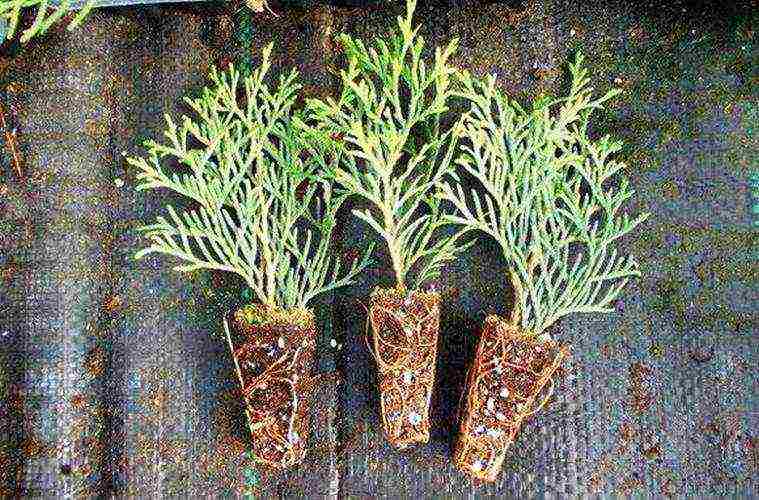
It is best to plant thuja in the spring, although sometimes it is done in the fall. But if possible, it is better to wait until next year, because a fragile plant may not withstand severe winter frosts. Autumn planting has several features, and it should be treated more demanding. Avoid transferring to the ground in late autumn, as in this case the plant has very little chance of taking root. Be sure to make sure that the root collar is not buried in the ground. Immediately after transplanting, it is recommended to add drugs that stimulate the development of the root system, for example, Kornevit.Treat the crown with Zircon twice more. Maintain an interval of 7 days between treatments.
Care in the garden for a spherical thuja
The plant does not impose high requirements on the composition of the soil, and grows well in the shade, however, the most favorable conditions for growth and development are well-lit places on the site.
Another distinctive feature of the globular thuja is its immunity to the polluted and dusty city air.
Among other things, the plant tolerates cold winters well, withstanding temperatures up to -40 degrees.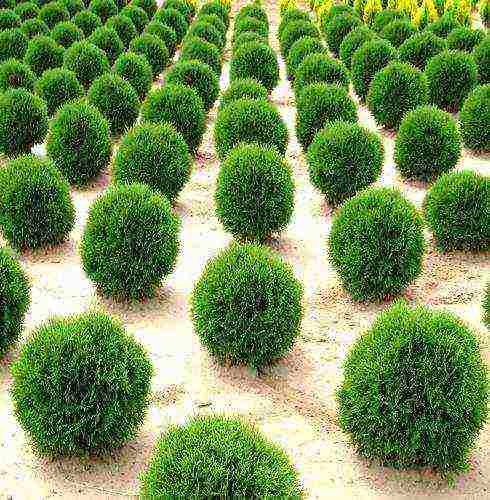
Even under artificial conditions, the spherical thuja lives for a long time - up to 150 years, however, if improperly handled, it can quickly wither, within just a few years.
Reproduction of thuja globular
The seed planting method is used only for thuja species, it is not suitable for the reproduction of its individual forms. Because in this case it will not be possible to preserve the decorative qualities of the plant. Compared to cuttings, the offspring from the seed comes out more hardy. However, it will take a long time to grow plants from seeds - from two to five years. Thuja seeds ripen in cones. For sowing, only selected and freshly harvested seed is used, which is prepared for this in a special way. Seeds are often left in the snow starting in the fall.
Getting a seed from a bump is not as easy as it sounds, because it has to open up. To do this, the cones are collected and transferred to a warm room, where they give seeds after two or even three days. Thuja seeds are soaked in water or wet sand for about ten hours before being lowered into the ground. The sowing is sprinkled with a thin layer of coniferous sawdust and covered with sun shields. The soil underneath should remain moist.
Columnar and spherical forms of thuja with the seed method of reproduction give offspring of both forms. For example, from the seeds of a thuja columnar, plants of a columnar and spherical shape can grow in equal quantities. It is possible to determine the type of young thuja only in the second year. Under favorable conditions, after one and a half to two years, on average, thuja can grow up to 60 cm in height.
Thuja spherical pruning
One of the most important care procedures for a globular thuja is pruning a bonsai. But you need to be especially careful and attentive to such a process in the first couple of years after the landing of such an exotic guest on your site. During this period, it is recommended to prune only the ends of the thuja branches. Thus, they will grow faster and better.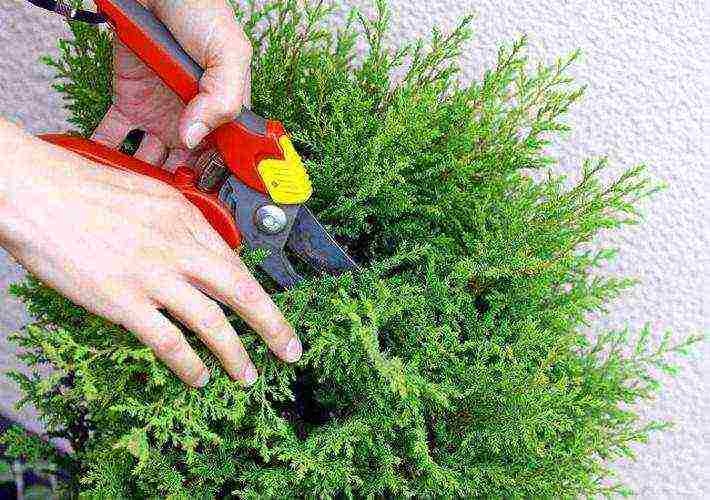
On a mature plant, three years after planting, the first sanitary pruning can be carried out. At any time of the year, dried and damaged elements - leaves and branches - can be removed from the plant. But in spring and autumn, such a process must be approached with special responsibility.
Fresh articles about garden and vegetable garden
Watering thuja globular in the garden
Watering. It is especially important to properly water the tree in the first month after planting. Weekly, you need to pour up to 10 liters under each bush, and in a drought, twice a week. If the plant lacks moisture, its crown begins to thin out. Immediately after watering, be sure to loosen the ground. The trunk circle should be up to 10 cm deep, then everything is covered with mulch with a layer of 7 cm.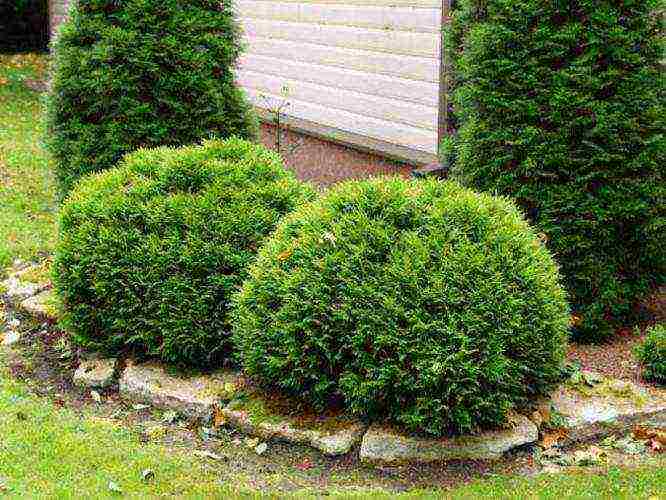
Top dressing. Fertilization should be started two years after planting. Every year in the spring, fertilizer is applied to the zone of the trunk circle at the rate of 100 g / m2. The drug Kemira - universal has proven itself well.
